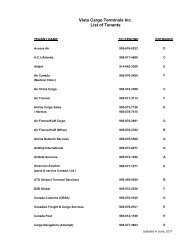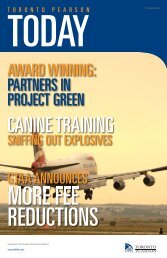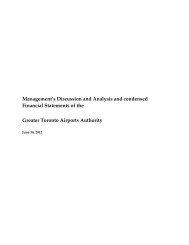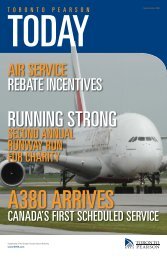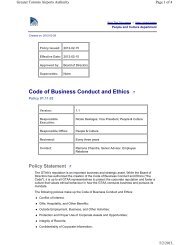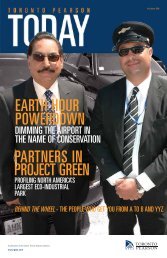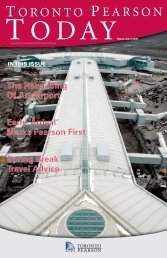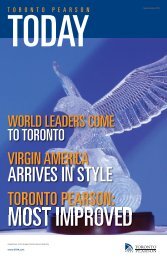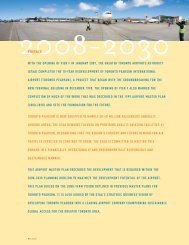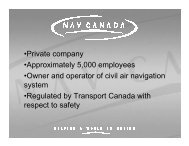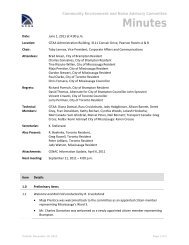Lights out - Toronto Pearson International Airport
Lights out - Toronto Pearson International Airport
Lights out - Toronto Pearson International Airport
You also want an ePaper? Increase the reach of your titles
YUMPU automatically turns print PDFs into web optimized ePapers that Google loves.
YEARS OF DEDICATION<br />
Steve Shaw retired from the GTAA as V.P. Marketing & Business Development in January 2009, after 16 years of service.<br />
Here, he gives a unique look back at the creation of the GTAA and the operation of <strong>Toronto</strong> <strong>Pearson</strong>, as well as his take on the future.<br />
It is late afternoon on January 6, 2009. I take one last look<br />
<strong>out</strong> my panoramic offi ce window at the airfi eld and then<br />
turn the lights off for the last time in my offi ce and walk<br />
<strong>out</strong>, no longer an employee of the GTAA.<br />
It is hard to think back sixteen years to when my involvement<br />
with the airport authority began. <strong>Pearson</strong> has been redeveloped,<br />
and the GTAA has matured into a sophisticated corporation.<br />
Yet for me, the moment of my leaving the GTAA is the end of<br />
an exciting and very fulfi lling journey. While it is personal, and<br />
so is my view of the way things were, there may be lessons to<br />
be gained by going back to the roots of the enterprise and the<br />
reasons and the politics around its beginning. The GTAA had<br />
indeed an unusual and precipitous birth and could easily have<br />
been a still born entity.<br />
Let me share with you my view of how it all began.<br />
I was in the Economic Development Division of the Metro<br />
Chairman’s Offi ce as a Senior Development Offi cer. In 1992 we<br />
were in a recession and my work related to the task of getting<br />
infrastructure projects started to jump start the economy of<br />
Metro <strong>Toronto</strong>. One of the initiatives that I began to hear ab<strong>out</strong><br />
was <strong>Pearson</strong> <strong>Airport</strong> and the opportunity to devolve its operation<br />
from Transport Canada to a “Local <strong>Airport</strong> Authority (LAA)”. The<br />
idea was simple: transfer the airport to a private corporation that<br />
could fund the much needed capital improvements to the airport<br />
and through its locally appointed Board could develop the airport<br />
for the economic benefi t of the local region.<br />
This “privatization” of airports had begun as a Conservative<br />
initiative and although it was eventually to be expanded and<br />
structured by the Liberals with the National <strong>Airport</strong>s Policy, the<br />
initial Conservative approach was pragmatic rather than policy<br />
driven. In the case of <strong>Toronto</strong>, this privatization effort had begun<br />
with the leasing of land for a private for-profi t company to build<br />
Terminal 3 (T3). While Transport Canada ran the airport, T3 would<br />
be managed separately under various agreements with Transport<br />
Canada to ensure traffi c, policing, etc. The success of the T3<br />
noise and the majority of directors should therefore be appointed<br />
by the City. <strong>Toronto</strong> obviously disagreed and the province also<br />
weighed in by setting up their own airport group.<br />
In the meantime, the potential economic benefits seemed<br />
to be evaporating along with any local community control and<br />
it was this issue that stirred action, particularly within Metro<br />
<strong>Toronto</strong>. The Boards of Trade and the Chambers of Commerce<br />
were very well-exercised regarding the failure to advance a<br />
process that would allow the airport to most benefit the economy<br />
of the region. The <strong>Toronto</strong> and Mississauga Boards in particular<br />
became strong champions of the LAA cause.<br />
Recognising the impasse, Metro Chairman Alan Tonks<br />
brought the issue to the Regional Chairmen who met regularly<br />
as the GO Transit Board. The six regional chairmen decided to<br />
establish a task force of persons from each region to try to come<br />
up with a proposal for a local airport authority that would have<br />
ii. The private business interests to be represented by<br />
the Boards of Trade/Chambers of Commerce of each Region<br />
proposing persons.<br />
iii. The distribution to be shared equally by all Regions<br />
meaning each region would get two nominees to the Board.<br />
iv. The LAA was to have a regional interest and therefore<br />
it was expected to operate other airports in the Region,<br />
(recognising Mississauga’s demand for the TCCA to be included)<br />
but it had to begin with gaining control of <strong>Pearson</strong>.<br />
Reflecting back, I realise the invaluable work the secretariat<br />
did to ensure that what was recommended was politically<br />
acceptable for each region. Key staff persons were those closely<br />
linked to the Chairmen and the economic development staff.<br />
These links continued through transfer and, while there have<br />
been many changes, have remained important to the effective<br />
work of the authority.<br />
The secretariat report was agreed to by the task force and<br />
the recommendations were accepted by the Regional Chairmen<br />
in the fall of 1992. Then began a fun period of getting all the<br />
municipalities in the GTA to pass resolutions agreeing with the<br />
report. It was a frantic and energizing time, which exposed the<br />
importance of the airport for the economy to a wide audience<br />
and brought the LAA concept to a new level of commitment from<br />
the municipal councils. In March 1993, the first Greater <strong>Toronto</strong><br />
Regional <strong>Airport</strong>s Authority (GTRAA) was incorporated and the<br />
Board of ten members, which included the five members of the<br />
Chairman’s Task Force, began immediately lobbying the federal<br />
government for recognition. It was a frustrating time because the<br />
Minister of Transport sought to avoid making any commitment to<br />
an LAA for <strong>Toronto</strong> while the government pushed ahead to lease<br />
Terminals 1 and 2 to a private company for redevelopment.<br />
Inevitably the GTRAA became more active politically and<br />
its lobbying efforts brought the support of the Liberal opposition.<br />
By mid-1993, <strong>Pearson</strong> and the proposed lease of the terminals<br />
was a growing political issue and the GTRAA did what it could to<br />
“Whatever the future of air travel, <strong>Pearson</strong> will be there because of the GTAA.”<br />
venture, which was clearly for profi t, encouraged the government<br />
to push ahead with a similar proposal for the redevelopment<br />
of Terminals 1 and 2, and this was to be followed by a further<br />
proposal to have a private operator manage the airfi eld.<br />
Beyond <strong>Toronto</strong>, the airport communities at Montreal,<br />
Calgary, Edmonton and Vancouver were working to set up notfor-profi<br />
t community corporations that would be recognised by<br />
the government as the bodies with which to negotiate a ground<br />
lease for their respective airports.<br />
These other airports, particularly Vancouver, had shown<br />
how important their airport was for the economic growth and<br />
wellbeing of their region. And with this came the opportunity for<br />
each region to market their airport, attract new air services and<br />
airlines and develop the airport facilities to match their vision of<br />
growth. In one stroke, it was argued, under local control and with<br />
access to funding, the airports would surge ahead freed from<br />
government control which funded airports according to political<br />
pressure not local demands. The example given was <strong>Toronto</strong><br />
which saw millions go from its revenues to build airports in other<br />
regions while <strong>Toronto</strong> had struggled with <strong>out</strong> of date facilities<br />
and restrictions on airline entrance to <strong>Toronto</strong> in favour of the<br />
“other” airports. This was the point at which I became involved.<br />
We were immediately sold on the importance of <strong>Pearson</strong> as<br />
the economic engine of the region and the fl agship for marketing<br />
<strong>Toronto</strong> to the world. But where was our group to be the authority,<br />
and what ab<strong>out</strong> the ongoing initiatives of the government to lease<br />
off parts of the airport to for-profi t companies If there was to be<br />
an airport authority at <strong>Toronto</strong> what would it do <strong>Toronto</strong> had tried<br />
in 1990 to get a group together but had failed to get agreement<br />
on the structure of the Board. It was all a matter of control and<br />
of money. Control, in the sense that local politicians wanted to<br />
be able to control, among other things, the noise issue. Money,<br />
in the sense that the redevelopment of the airport was seen to<br />
likely generate millions of dollars in development charges for the<br />
City. The City of Mississauga argued that the airport was mainly<br />
in their municipality, which was also most impacted by aircraft<br />
broad acceptance. This was mid-1992.<br />
The situation was complex and challenging:<br />
• The government was moving ahead to further split<br />
up <strong>Pearson</strong> and have for-profit companies build further new<br />
terminals, and develop the airside. This was seen by many in the<br />
airport business as creating a difficult management structure for<br />
whoever actually operated the entire airport.<br />
• There was local political pressure to keep political<br />
influence over the airport management.<br />
• The Region of Peel and the City of Mississauga were<br />
debating who was to represent the host municipality.<br />
• The City of Mississauga insisted that <strong>Toronto</strong> City<br />
Centre <strong>Airport</strong> (TCCA) and <strong>Pearson</strong> had to be transferred together.<br />
• The Province wanted to have a role and was looking at<br />
supporting a response to the RFP for the new Terminal 1/2.<br />
• The Minister of Transport was stalling on the<br />
Local Authority initiative in <strong>Toronto</strong>, demanding no political<br />
appointments to any Board and unanimous resolutions from all<br />
municipalities in the GTA supporting any proposed LAA.<br />
• It was uncertain if one authority was going to operate<br />
just <strong>Pearson</strong> or other airports, even though Hamilton had<br />
separated themselves.<br />
• If the terminals were privatized <strong>out</strong>side of an authority,<br />
it was unclear what revenue sources an LAA would have.<br />
Yet the Chairman’s Task Force began their work; there was<br />
no time to lose. A secretariat was established to provide staff<br />
support. It was made up of economic development staff and other<br />
key personnel from the five regions. This group, which I chaired,<br />
supported the Task Force and over the course of four months<br />
produced a report with recommendations for the structure of a<br />
LAA. There is much that could be said ab<strong>out</strong> the effort to get<br />
agreement but the breakthrough came with the following four<br />
ideas:<br />
i. The political interests to be represented by allowing<br />
the regions to nominate members to the Board but ensuring no<br />
politicians.<br />
promote the need for an airport authority. The election in October<br />
1993 saw the Liberals come into government by a landslide and<br />
the eventual cancellation of the Terminal 1/2 contract. The<br />
new government produced the National <strong>Airport</strong>s Policy in July<br />
1994 which set <strong>out</strong> a modified structure for airport authorities,<br />
(renamed Canadian <strong>Airport</strong> Authorities) and the GTRAA was<br />
reconstituted into the GTAA with the Board being expanded to<br />
fifteen members. I remember with satisfaction, the moment in<br />
early December 1994, when the Minister of Transport, Doug<br />
Young, signed the document in Terminal 2 recognising the GTAA<br />
as the airport authority which the government would negotiate<br />
with to transfer <strong>Pearson</strong>. It incidentally marked my last day as a<br />
Metro employee and I began the next day as a contract employee<br />
with the GTAA; their first.<br />
What the GTAA became reflected those early beginnings:<br />
• The close relationship to the Regional Chairmen;<br />
• The importance of regional economic development in<br />
the vision and work of the authority;<br />
• The need to bring all parts of the airport back under the<br />
control of the GTAA;<br />
• The concept of common use facilities for all airlines;<br />
• The need to protect against inappropriate pressure for<br />
money or influence over airport management;<br />
• The need to build <strong>Pearson</strong> as an integral facility for the<br />
long-term future.<br />
And so back to the present. I leave an authority that has<br />
matured as a corporation, built excellent facilities with capacity<br />
for the future, and has good relations with its many communities<br />
of interest. Although 2009/10 has major financial challenges<br />
with expected traffic drops and tight budgets, I look beyond and<br />
see what those first Board members saw; an airport run as a<br />
not-for-profit corporation, for the economic wellbeing of the GTA,<br />
the province and the country, being always a part of the success<br />
story of <strong>Toronto</strong>. Whatever the future of air travel, <strong>Pearson</strong> will<br />
be there because of the GTAA.<br />
<strong>Toronto</strong> <strong>Pearson</strong> Today First Quarter 2009 9



